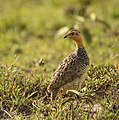Coqui francolin
| Coqui francolin | |
|---|---|

| |
| Adult male of the "Pale-bellied francolin", P. c. hubbardi, in the Maasai Mara | |
| Scientific classification | |
| Domain: | Eukaryota |
| Kingdom: | Animalia |
| Phylum: | Chordata |
| Class: | Aves |
| Order: | Galliformes |
| Family: | Phasianidae |
| Genus: | Campocolinus |
| Species: | C. coqui
|
| Binomial name | |
| Campocolinus coqui (Smith, 1836)
| |
| Synonyms[2] | |
|
Francolinus coqui | |
The Coqui francolin (Campocolinus coqui) is a species of bird in the family Phasianidae.
Taxonomy
[edit]Formerly classified in the genus Peliperdix, a 2020 study found it, the white-throated francolin (C. albogularis), and Schlegel's francolin (C. schlegelii) together comprise a new genus Campocolinus.[3] The International Ornithological Congress has accepted these findings.[4]
Range
[edit]It is mainly found in Africa's southern half but is also sparsely present in the western Sahel and Ethiopia. It is believed to be the most widespread francolin in Africa.
Habitat
[edit]It mainly inhabits grasslands, steppes, savannas and dry scrubland, but also bright forest and grain fields. On high plateaus it lives up to 2,000 meters high. It is mostly resident throughout its range.[5]
Gallery
[edit]-
Male of nominate race, eastern Botswana
-
Female of nominate race, Limpopo
-
P. c. hubbardi pair in the Serengeti, Tanzania
-
P. c. hubbardi female in the Serengeti, Tanzania
-
P. c. maharao, male, in Tarangire N.P., Tanzania
-
At Masai Mara
-
At Masai Mara
References
[edit]- ^ BirdLife International (2017). "Peliperdix coqui". The IUCN Red List of Threatened Species. 2017. IUCN: e.T22678736A111663262. doi:10.2305/IUCN.UK.2017-1.RLTS.T22678736A111663262.en.
- ^ "Francolinus coqui". Avibase.
- ^ Crowe, Timothy M.; Mandiwana-Neudani, Tshifhiwa G.; Donsker, David B.; Bowie, Rauri CK; Little, Robin M. (2 April 2020). "Resolving nomenclatural 'confusion' vis-à-vis Latham's Francolin (Francolinus/Peliperdix/Afrocolinus lathami) and the 'Red-tailed' francolins (Francolinus/Ortygornis/Peliperdix spp.)". Ostrich. 91 (2): 134–136. Bibcode:2020Ostri..91..134C. doi:10.2989/00306525.2020.1723140. ISSN 0030-6525.
- ^ "Taxonomic Updates – IOC World Bird List". Retrieved 14 July 2021.
- ^ Species text in The Atlas of Southern African Birds








